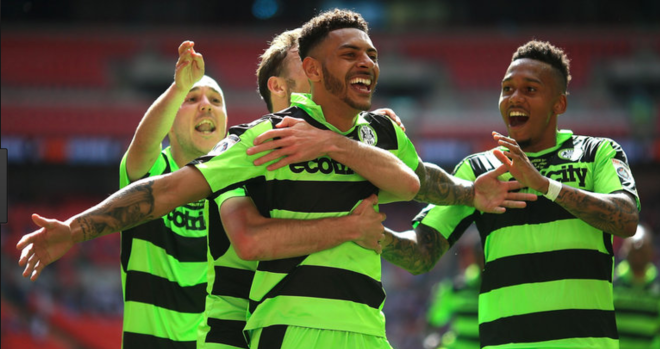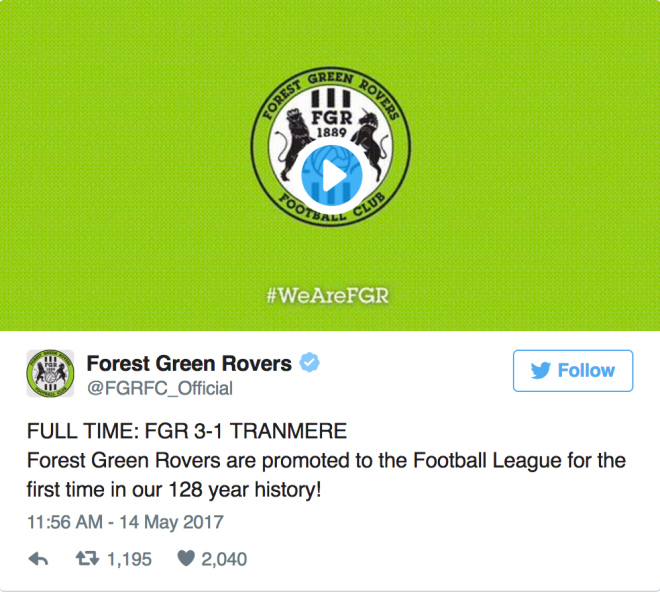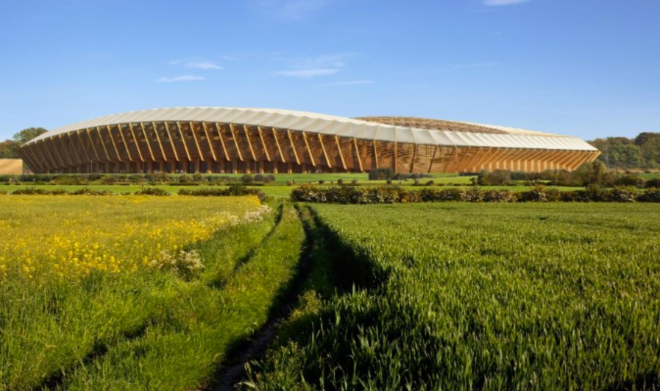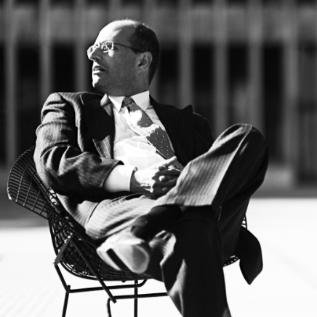- May 19, 2017
- Posted by: SportsV
- Categories: Case Studies, Featured Articles, Features, Home News, Industry News, News

In the following article, entitled ‘Forest Green Rovers, Greenest Team in Sports, Earns Promotion Up England’s Football (Soccer) Ladder’, Lewis Blaustein, President, Lewis Brand Solutions; Founder & Chief Blogger at GreenSportsBlog; and Host, Green Gotham TV, outlines why the English Football League’s newest club, Forest Green Rovers (FGR), is the ‘Greenest Team in Sports’ today.
In the almost four year existence of GreenSportsBlog (GSB), we have written more stories about fifth tier English soccer/football club Forest Green Rovers (FGR) than any other team or topic—12 times to be exact. Why? FGR is, clearly to GSB, the Greenest Team in Sports. From rooftop solar to mowing the lawn with a solar powered “mow-bot” (I kid you not!) to the now famous vegan-only food concessions, FGR is at the cutting-edge of Green-Sports. And, as of Sunday they are no longer in the fifth tier of English soccer. After beating Tranmere, 3-1, in a playoff match at London’s fabled Wembley Stadium, FGR earned promotion to the fourth tier (aka League Two), for the first time ever. This is huge, from both football and greening perspectives.
I am quite sure you’ve never heard of Kaiyne Woolery. But he may well be one of the most important people in Green-Sports today—and he likely has no idea about that fact.
Woolery scored two goals to lead Forest Green Rovers, aka the Greenest Team in Sports, to a 3-1 win over Tranmere Rovers on Sunday at Wembley Stadium in London. The playoff victory earned FGR promotion from the National League (the fifth tier of English football) to League Two (fourth tier).

Kaiyne Woolery celebrates one of his two goals for Forest Green Rovers in Sunday’s promotion 3-1 playoff win at London’s Wembley Stadium over Tranmere. FGR moves up to League Two, the 4th tier of English football, next season (Photo credit: Sky Sports)
You simply cannot overstate the impact of this win, abetted by Woolery’s two goals, both in terms of football and FGR’s sustainability/climate change fighting mission.
MOVING ON UP
From a football perspective, consider that Forest Green Rovers has been in existence since 1889 and has never made it up to the fourth tier (FYI, there are 24 tiers in English football, with over 7,000 clubs).
In most countries—but not the US and Canada—professional soccer operates a system of promotion and relegation. Clubs that finish at or near the top of a league are promoted to the league above for the following season. Teams that end up at or near the bottom get relegated to the league below. If you want more information on promotion and relegation, check out this schematic, which maps out the top nine tiers of English football, and/or click here.

The English Football Pyramid. Forest Green Rovers won promotion from the 5th Level (Conference National) to the 4th Level (League Two), the highest tier it has ever achieved. (Credit: An American’s Guide to English Soccer)
For most of its 128 year existence, FGR rattled around a maze of English local, county and regional leagues, moving up and down over the decades, never getting above the sixth tier. In 1997-98, they made it up to the National League, the fifth tier of English soccer. While that was an accomplishment, let’s put it in its proper perspective: In baseball terms, the fifth tier is the equivalent of the low minor leagues. FGR’s quaint and sustainable home ground, The New Lawn, has a capacity of about 5,100, similar to most of its (now former) National League compatriots.
The club largely teetered between relegation and mediocrity until Dale Vince, OBE^, owner of Ecotricity, a solar and wind provider, bought the club in 2010. They started slowly but hit on an upward trajectory that led to FGR making the promotion playoffs in 2015 and 2016. They fell short both years but the third time proved to be a charm on Sunday. Before a crowd of almost 19,000 at Wembley Stadium in London, the club earned promotion to League Two with Woolery’s 11th and 44th minute goals sandwiching one from Christian Doidge in the 41st.
The honeymoon will be brief for the coaches, players and supporters, many of whom flooded The New Lawn for a celebration Monday night. FGR’s first League Two season starts in just three months (it’s a loooooong season!). Some higher caliber talent will need to be added to the core of this season’s group to make sure Forest Green Rovers stays in the fourth tier and doesn’t face relegation.
LEAGUE TWO: BIGGER MEGAPHONE FOR FGR’S GREENNESS
From a sustainability perspective, the implications of Woolery’s two goals and of the resulting move up the ladder are also massive.
One might not think going from the fifth to fourth tier is that big a deal. Trust me; it is.
- Sky Sports, a British version of ESPN, broadcasts League Two matches, providing those clubs with greater media exposure, and thus a bigger audience, than their National League counterparts (without a national broadcast deal) can hope for. And that means a bigger audience for stories about FGR’s greenness, the vegan only food, the mow-bot, etc.
- With its ascension to League Two, FGR is now, per the schematic above, part of The Football League, the organization that oversees the second, third and fourth tiers. This is important because FGR can take part in two domestic, knock-out Cup competitions, the League Cup (includes the Premier League teams) and the League Trophy (open to League One and Two clubs only) that are not open to National League clubs or below. And that means they will share in yet more additional revenue. The more famous and prestigious FA Cup is open to all levels.

- The TV deal and the additional Cup exposure will result in a financial windfall for the club, estimated by one source to be between $1-$2 million. That is rounding error compared to the estimated $220 million influx for each of the three teams that get promoted from the second tier Championship to the Premier League. But $1-$2 million can be a big deal in the Forest Green Rovers world. It will allow Mr. Vince to attract a higher level of talent. And perhaps he will be able to move forward on some new sustainability initiatives.
The highest profile sustainability-focused project on Mr. Vince’s docket is FGR’s new stadium. To be clear, the world’s first all-wood stadium was in the planning phase before this season started.
Now, I know what you’re thinking: “Did you say all-wood stadium?”
Yes. Mr. Vince and company is planning an all (fire-retardant treated) wood stadium. In a meadow.

Computer-aided design of the exterior of the planned all-wood Forest Green Rovers stadium. (Courtesy Forest Green Rovers and Zaha Hadid Architects)
Mr. Vince, in a story by George Ramsey that ran Tuesday on CNN.com, said:
The importance of wood is not only that it’s naturally occurring, [but that] it has very low embodied carbon — about as low as it gets for a building material. And when you bear in mind that around three-quarters of the lifetime carbon impact of any stadium comes from its building materials, you can see why that’s so important — and it’s why our new stadium will have the lowest embodiment of carbon of any stadium.

Computer-aided design of the interior of the planned Forest Green Rovers stadium. (Courtesy Forest Green Rovers and Zaha Hadid Architects)
Designed by Zaha Hadid Architects, the stadium will be topped by a translucent, sloping roof to reduce shadows on the pitch (field) and aid in grass growth. Venue walkways have been fashioned to allow better ventilation and maintenance of the field.
The first 53 seconds of this 6:44 video from TomoNews provides details about Forest Green Rovers’ proposed all-wood stadium.
If all goes to plan, the stadium will be the hub of a 100-acre Eco Park. At an estimated cost of $123 million, the park will include facilities for both the community and the club: gyms, all-weather soccer pitches/fields, sports science clinics, as well as a conference center.
The project still needs approval from local authorities, so Mr. Vince asked the fans present at Monday’s promotion celebration to write to the Stroud District Council in support of the stadium—another benefit of promotion to League Two.
But don’t think that Mr. Vince is content to stop at League Two. He was quoted at the celebration by Aled Thomas in Gloucestershire Live as saying, “I think we’ll have a good first season in League Two and will be there or thereabouts for promotion – I’m aiming for League One and then the Championship.”
And the FGR owner is also aiming, with his club’s higher profile, to show his fellow owners that green is good for business and good for football.
^ OBE = Order of the British Empire, a level of chivalry in the United Kingdom.
If you have any comments about this article, please contact Lewis directly at the below coordinates:
Email: lew@greensportsblog.com
‘Friend’ us on Facebook: http://facebook.com/greensportsblog
Tweet us: @GreenSportsBlog


